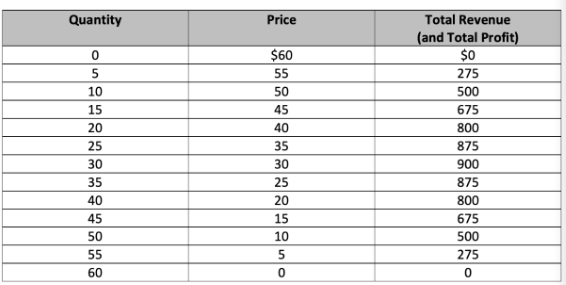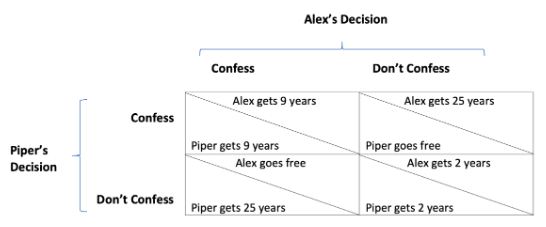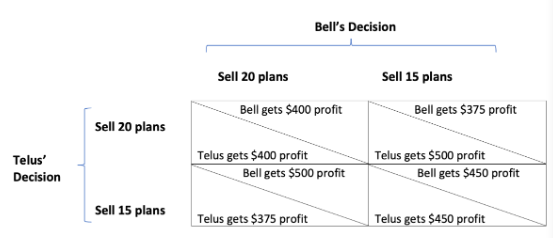Chapter 18: Oligopolies and Game Theory
oligopoly: a market where a few sellers supply similar or identical products
examples of oligopolies: using AirCanada or Westjet / Rogers, Bell, or Telus / five main banks in Canada
A key trait of oligopolies is that there are only a few sellers. This means that the actions of one seller in the market can have a significant effect on other sellers.
Game theory: the study of strategic decision-making while keeping in mind how others will react to the decision. While playing poker you have to be mindful of what other people are playing and betting on. It takes strategy.
Game theory is not that useful for the other three business structures. - Competitive, monopoly, and competitive monopoly. In those, a single business doesn’t have much influence on the market.
Businesses in an oligopoly are best off if they cooperate and act as a monopoly. However, each business is only concerned with its own profit, so there is an incentive to compete.
Duopoly Example
Duopoly: oligopoly with only two sellers
suppose a small town only has two phone services, Telus and Bell, they meet once a month to decide the number of plans they will provide. Assume they offer calling, data, and text messages at no cost. They only offer one type of plan and do not sell phones. So marginal cost =0 for both companies.

before we examine imagine if it was a competitive monopoly; the decision of each business would drive the price down until the marginal cost equals 0, and the equilibrium price would be 0.
now imagine how a monopoly would behave; profit is maximized when 30 plans are sold for $30. Therefore a profit-maximizing monopolist would supply that quantity at that price.
So what happens in a duopoly? Telus and Bell would agree on the number of plans to sell and the price. These businesses are in a cartel. When a cartel is created, the market is basically now a monopolist.
collusion: when businesses meet and agree on quantity to sell and prices.
Cartel: a group of businesses that are cooperating
The cartel not only chooses the number of supplies but also how much business will produce. 50/50, 30/70 however each one produces, but more produced = more profit.
Oligopoly Equilibrium
It is difficult for duopolies to actually practice. Cartel members argue over things like how to split the profit. Many countries have laws that make forming a cartel illegal.
So how would Telus and Bell function when making decisions independently? Suppose Telus expects Bell to see 15 phone plans (half the monopoly output) Telus would then consider two strategies;
- also sell 15 phone plans so a total of 30 would be sold because the table says the price at 15 would be $30, and the profit would be $450 (15x30).
- Telus could sell 20 phone plans. A total of 35 would then be sold for $25 for a profit of $500. Although the total market profit is lower, Telus has a high profit because they have a bigger slice of the market.
But then Bell would do the same and the price would decrease to $20. If the two businesses focus on their own self-interest they supply a total that is larger than the monopoly quantity, charge a lower monopoly price and get a profit lower than the monopoly profit.
So the pursuit of self-interest pushes the duopolies’ output higher than the monopoly amount. Because they are now both selling 20 plans each, they have a profit of $400. If Telus then tried to sell 25 plans the profit would fall from $400 to $375 so they would not sell more as profit is higher when they sell 20, Bell would reason the same and they would both continue to sell 20 plans each.
The plan when both sell 20 plans is the equilibrium as neither has the incentive to change. That’s called a Nash equilibrium (named after John Nash)
Nash equilibrium: occurs when people interacting with one another each choose the best action given the actions the other people have chosen.
Telus Bell demonstrates the tension between cooperation and self-interest. Businesses would be better off if they colluded (cooperated).
Oligopolists do not raise production until price equals marginal cost.
How the Number of Businesses Influences an Oligopoly Market
What happens when there are more than two businesses?
Imagine there are two new companies now, Koodo and Fido. The demand table is unchanged, but there are now more sellers. The four businesses would try to form a cartel. But that is even more unlikely with four than it is with two. (also illegal in Canada lol)
What happens when an individual business sells one more plan:
- the output effect: selling one more unit increases profit since the price is above the marginal cost
- the price effect: selling one more unit increases the market quantity supplied, which will reduce the price of cell phone plans and reduce the profits on all of the other phone plans that were sold.
When the output effect exceeds the price effect a cell phone business will sell more plans; and if the price effect exceeds the output effect, a business will not sell another plan. In general, individual oligopolies will raise production until the two effects equal each other.
The higher number of businesses the less an individual worries about their influence on the market price. In other words, the more businesses that enter the market the price effect is diminished, as the market becomes bigger, the price effect vanishes. Then the individual is now a price taker.
Prices in oligopolies are considerably higher than in competitive markets.
The Prisoners Dilemma
The prisoner’s dilemma is a fictional story of two prisoners, well call them Alex and Piper. They have been caught and the police have enough evidence to put them away for one year, however, they think that the prisoners have been involved in a more serious crime but do not have enough evidence of that. So the police take each prisoner to an operating room and tell them “We have enough evidence to put you in jail for 2 years. However, if you confess to the other crime and implicate your partner, then you will walk free with no jail time and your partner will spend 25 years in jail. But if you both confess then you will both go to jail for 9 years.”S

Assume that Alex and Piper have no communication, no oath or code. Each prisoner would then act in self-interest. If Piper does not confess it would be in Alex’s best interest to confess so they both only get 9 years. If piper does not confess it would Alex's best interest to confess and walk out free and not spend the 2 years. So Alex has a dominant strategy.
dominant strategy: a strategy that is best for a person to choose regardless of the strategies chosen by other people they are interacting with.
Now from Piper’s perspective. She faces the same choices as Alex and will likely reason in the same way. So in that way piper also has a dominant strategy. So Alex and Piper end with a nash equilibrium. They both are choosing their best strategy when pursuing self-interest. But there could have been a better outcome if they both did not confess. It is difficult to maintain because each person would be going against their own self-interest.
Oligopolies and the Prisoners’ Dilemma

Telus and Bell are the only two businesses again. Assume they both agree to sell 15 phone plans each. After the agreement, they chose to honour the agreement or cheat.
Telus Perspective:
two strategies, cooperate and sell 15, or cheat and sell 20. Telus does not know what strategy bell will choose. If Bell cooperates it would be a better profit to cheat. If Bell cheats it would be in Teulu’s best interest to cheat. So Telus has a dominant strategy to cheat.
Bell Perspective:
Bell faces the same choices as Telus and will react in the same way. So far in the game, the Nash equilibrium is for both businesses to cheat and sell 20 plans. This equilibrium makes both worse off t=relative to the outcome where they both cooperate and only sell 15.
This game shows why oligopolies struggle to cooperate and reach the monopoly outcome. Not all games have a nash equilibrium.
other examples of the prisoner’s dilemma:
Advertising wars:
If two companies are both trying to attract the same customers.
Common Resources:
Fishermen fishing in the same lake agree to only use one boat or cheat and use two risking depleting the fish population.
How the prisoners’ Dilemma impacts Society’s Welfare
Sometimes a lack of cooperation can be good for society. The monopoly results can benefit sellers but hurt buyers. Remember the competitive outcome is the optimal outcome for society because that’s where surplus is maximized.
Sometimes a lack of cooperation is bad for society. In the fishing example, the lack of cooperation ended with the fish population being depleted. Society would have been better off if the fishermen cooperated.
Why cooperation can occur
The reason why players sometimes cooperate is that the game has been played many times before.
Maybe there are rules in place for what to do if you cheat.
Public Policy Toward Oligopolies
Cooperation causes production to be too low and prices too high, which creates deadweight loss.
Canada’s Competition Bureau helps ensure that monopolies do not get too large and cartels are not created.